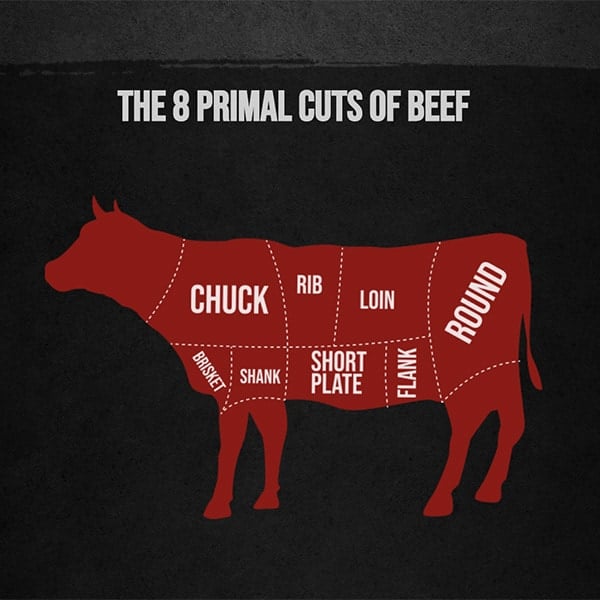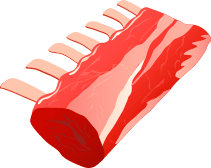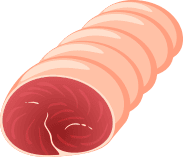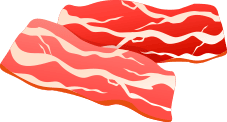The 8 Primal Cuts of Beef
Published Oct 31, 2018
Updated Sep 05, 2024
This post may contain affiliate links. Please read my privacy policy.
Cuts of Beef - a comprehensive guide with pictures of the 8 primal cuts of beef: brisket, shank, rib, loin, round, chuck, flank and short plate. Learn the difference and the best cooking method for each cut of beef.

What Are The Different Cuts Of Beef
Cuts of beef has always been a topic that many readers ask. What is the best cut of beef to use for a particular recipe. Today, I am sharing a How To Tutorial written by Bro BBQ on the 8 primal cuts of beef.
This article will explain in details every cut of beef and the best preparation and cooking methods. Check out Bro BBQ to learn more about BBQ recipes and all things BBQ!
The 8 Primal Cuts Of Beef
1. Brisket

Best Cooking Methods: Braising, slow cooking, smoking, stewing, pot roasting.
Preparation Methods: Brisket is best prepared with a dark and robust marinade or brine for at least 4 hours to start. Usually a dry pepper rub consisting of spices and seasonings is used to coat the entire brisket.
This is what creates the dark, crispy exterior of the brisket also known as the “bark”.
Type of grill/smoker when BBQing: An indirect heat smoker is one of the best choices of equipment to use when smoking brisket. Low temperatures are easy to maintain with an indirect heat smoker which is ideal for cooking brisket.
2. Shank

Best Cooking Methods: The meat contains very little fat and therefore is very tough. It must be cooked for long periods of time either at low temperatures in appliances like crockpots or at higher temperatures in the oven. This will help to break down the structure of the beef.
Preparation methods: In order to prepare a shank, you will want to help break down the meat using a meat tenderizer seasoning or mallet.
A marinade will also help to not only tenderize the meat but also bring extra flavors to this tough cut of beef.
Type of grill/smoker when BBQing: Conventional oven or crockpot for roasts and stews and any direct heat grill for ground beef.
3. Rib

Best Cooking Methods: Prime rib is best cooked at a very high temperature for a short period of time to create a crispy exterior and rare center.
Ribeye steaks are best cooked on a direct heat grill. Any fuel type will work but charcoal will be the best for adding flavor to the meat.
Short ribs are best when braised first to break down the meat structure. Back ribs are best when rubbed with dry rub or wet rub then smoked in an offset smoker for at low temperatures for a long period of time.
Preparation Methods: Prime rib is prepped with a dry rub of spices and seasonings before cooking. Ribeye steaks are a type of steak cut that does not need any prepping at all.
Short ribs have to be cut by a butcher to a specific length before cooking. Back ribs can be prepared like any other rib. For recipe ideas, click here.
Type of grill/smoker when BBQing: Prime Rib – Conventional oven or direct heat smoker. Ribeye Steaks – Direct heat grill. Short ribs – Conventional oven and direct heat grill. Back ribs – Indirect heat smoker or your best smoker.
4. Loin

Best Cooking Methods: Porterhouse, T-bone and club steaks are best when they are grilled to a desired temperature, most commonly medium rare.
A seasoning or salt and pepper is added to the steaks either before or after cooking.
Filet Mignon, Chateaubriand and tri tip are best when they are grilled to a desired temperature, most commonly medium rare. New York strip and Sirloin steak are best when they are grilled to a desired temperature, most commonly medium rare. A seasoning or salt and pepper is added to the steaks either before or after cooking.
Preparation Methods: Porterhouse, T-bone and club steaks do not need much prepping, just a little bit of seasoning. Filet Mignon, Chateaubriand and tri tip are very delicate cuts of beef and need lots of attention.
If you have a thick cut, you may want to butterfly the steak before cooking in order to have a more even cook. New York strip and Sirloin steaks can be prepped with just a little seasoning or salt and pepper.
Type of grill/smoker when BBQing: Porterhouse, T-bone and club steaks – Direct heat grill or open flame grill. Filet Mignon, Chateaubriand and tri tip – Direct heat grill, conventional oven or open flame grill. New York strip and Sirloin steak – Direct heat grill or open flame grill
5. Round

Best Cooking Methods: Best when cooked low and slow in an oven with liquid. Also cut thinly and dried out to make jerky. Ground up round is very lean and needs extra fat put into it like eggs so that the meat doesn’t dry out when it is cooking.
Preparation Methods: If you plan on making into jerky then you need to cut small, thin strips of the beef and heavily season them with spices depending on the flavors you want.
For braising, just make sure the cut of meat is completely submerged in liquid or injected.
Type of grill/smoker when BBQing: Conventional oven
6. Chuck

Best Cooking Methods: The shoulder and neck are best when cooked in an oven with liquid for long periods of time on low temperatures otherwise known as braising.
Beef Ribs are best when they are coated in a dry rub or wet rub and sometimes a marinade. Then smoked over an indirect heat smoker on low temperature for long periods of time.
Blade or flat iron steaks have a lot of fat marbling and are usually known as a butcher steak because this is the best cut in the cow, usually the butcher keeps this cut for himself.
Chuck steak and chuck filet are usually tenderized and pounded out then coated in egg and breading to create chicken fried steaks or roulade.
Preparation Methods: The shoulder and neck need a heavy seasoning or rub before braising or pressure cooking.
Beef Ribs can be boiled on the stove for an hour before smoking or grilling to help in breaking down the meat structure, creating a more tender end product.
Blade does not need any prepping at all. Just grill it. Chuck steak and chuck filet need to be tenderized with a meat mallet before cooking.
Type of grill/smoker when BBQing: The shoulder and neck: Conventional oven. Beef Ribs: Indirect heat smoker and charcoal grill. Blade: direct heat grill or open flame grill. Chuck steak and chuck filet: conventional oven, skillet, direct heat grill
7. Flank

Best Cooking Methods: The Flank steak is usually marinated for long periods of time or overnight them coated with a dry rub. It is then grilled to medium and cut into bite sized strips.
Preparation Methods: Tenderize this cut of meat with a meat mallet or meat tenderizer seasoning before cooking it.
Also, it is preferred by many to marinate the flank steak in a highly acidic marinade. Acidic marinades contain juice from fruit like limes and lemons which help even further to tenderize meat.
Type of grill/smoker when BBQing: Direct heat grill or open flame grill
8. Short Plate

Best Cooking Methods: Hangar steaks: This highly coveted steak is very tender when cooked properly. Skirt steak is usually marinated for long periods of time then coated in a dry or wet rub and grilled over direct heat.
Preparation Methods: Hangar Steaks do not need any prepping done to them, maybe just a little seasoning or salt and pepper to accent the flavors of the wonderful cut of beef.
Skirt steak will benefit from a strong acidic marinade over night or for at least 12 hours. With all the fibers in this cut, the acidic marinade with loosen up those beef parts.
Type of grill/smoker when BBQing: Hangar steaks: Direct heat grill or open flame grill. Skirt steak: Direct heat grill or open flame grill.
So, what is the best cut of beef? There really is not one cut that is the best.
“Beauty is in the eye of the beholder, and beauty is subjective”. While one person may prefer a medium rare filet mignon, another may prefer a well-done pot roast.
Temperature will always be a huge factor in how someone likes their meat prepared, click here to see a cuts of beef chart and their proper temperatures.
You also will not have to worry about breaking down any of the primal cuts of beef. The Butcher at the supermarket always breaks down the primal beef cuts into the sub-primal beef cuts.






Resting for such a short period will not make much different in the heat of your food. If you have ever had a streak in a restaurant they would have rest this also. Did you find this too cold?
Resting? I like my food hot and it cools down during the resting period. What is preferred way of reheating it???
I won’t argue the pros and cons of resting with you. The simple answer here, if having your meat hot is your priority, is to serve it straight away after cooking.
Just be aware that others may not consider that the “best” way of serving and eating.
After you let it rest for a bit, than when you cut it, you won’t lose the juiciness.
Which you do when cut right away and when you like it red, also the blood is on your cuttingboard in stead of in the meat.
Louise van der Marel
Actually, prime rib is best cooked at a low temperature (approx 200 degrees F). You should season the meat a couple of days in advance. When it reaches the desired temperature (about 45-55 min/lb for a bone cut), it is then seared under high heat. This is known as a reverse sear. It will give you a finished cut without a gray band around the edges. It also loses less juices in the meat. This is how most high end restaurants cook their prime ribs.